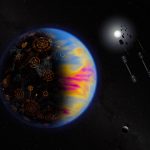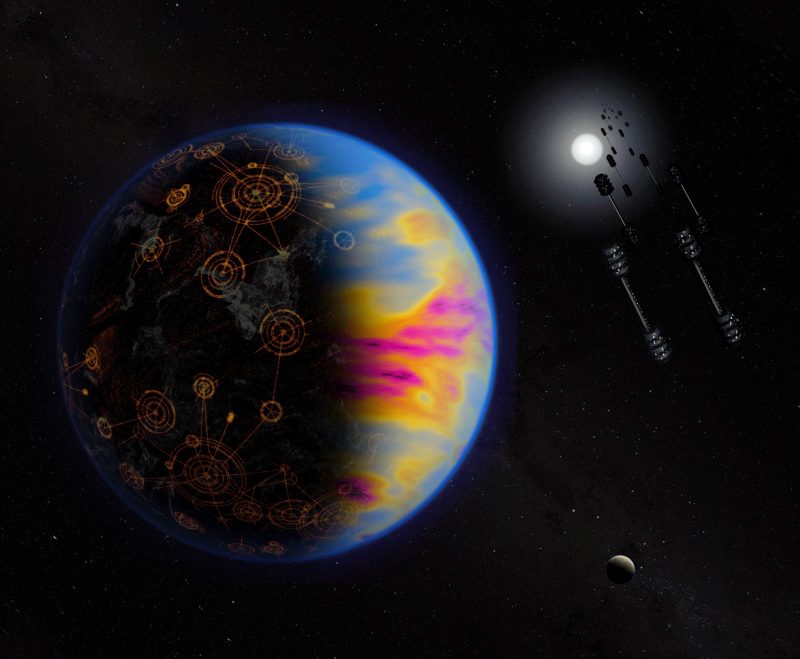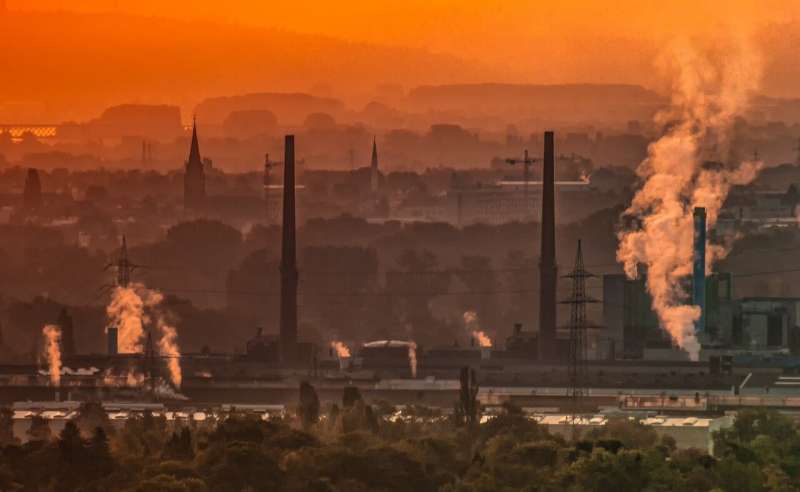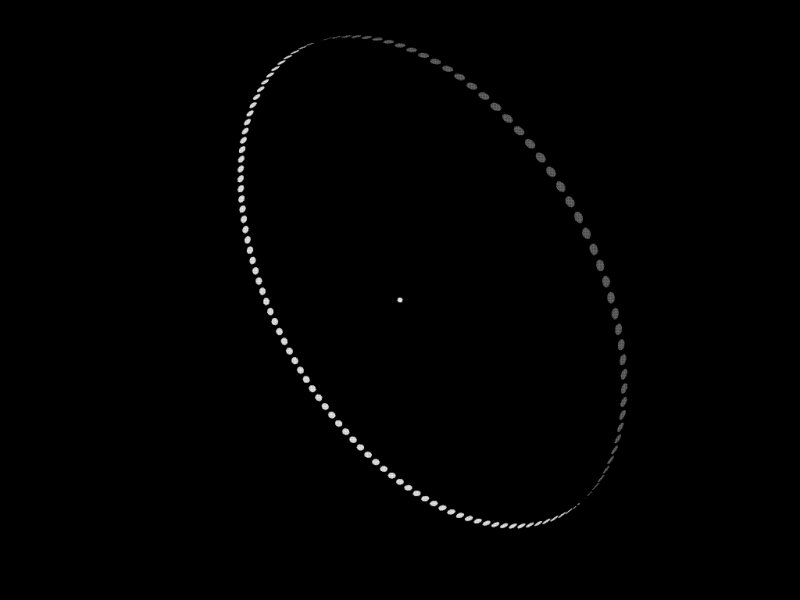

Artist’s concept of an advanced alien civilization on a distant exoplanet. A new study suggests that some alien societies might pollute their planets’ atmospheres in a manner similar to our own. If so, we might be able to detect it. Image via NASA/ Jay Freidlander.
Early SETI – Searches for Extraterrestrial Intelligence – focused solely on looking for artificial radio signals. Much of SETI still leans that way, but the search has now broadened to include the idea of searching for technosignatures (signs of advanced technologies) from alien civilizations, living on distant planets. Scientists are now discussing and even beginning to hunt for signals from, for example, optical lasers or even giant structures like Dyson spheres. On February 10, 2021, researchers from NASA’s Goddard Space Flight Center announced another way to search that’s reminiscent of earthly civilizations. They proposed looking at atmospheres on exoplanets for evidence of air pollution.
Their idea is to hunt specifically for nitrogen dioxide gas (NO2), produced on Earth primarily by the burning of fossil fuels. NO2 can also originate from natural sources such as biology, lightning or volcanoes. The new research paper, not yet peer-reviewed, was submitted to arXiv on February 9, 2021 and will be published in The Astrophysical Journal. Lead author Ravi Kopparapu explained in a statement:
On Earth, most of the nitrogen dioxide is emitted from human activity, combustion processes such as vehicle emissions and fossil-fueled power plants. In the lower atmosphere (about 10 to 15 kms or around 6.2 to 9.3 miles), NO2 from human activities dominate compared to non-human sources.
Therefore, observing NO2 on a habitable planet could potentially indicate the presence of an industrialized civilization.
This study and others like it are based on the fact that, presumably and as far as earthly scientists can tell, chemistry works the same way beyond Earth as on Earth.

Earthly nitrogen dioxide (NO2) is produced mainly by vehicle emissions and fossil-fueled power plants. Could it be a sign of alien intelligence on a distant world? Image via CC0 Public Domain/ Phys.org.
Scientists are also interested now in looking for possible natural biosignatures – evidence for active biology of some kind – in the form of combinations of certain gases in an exoplanet’s atmosphere, like methane and oxygen. But this new study is the first time that NO2 has been suggested as a possible technosignature. Co-author Jacob Haqq-Misra said:
Other studies have examined chlorofluorocarbons (CFCs) as possible technosignatures, which are industrial products that were widely used as refrigerants until they were phased out because of their role in ozone depletion. CFCs are also a powerful greenhouse gas that could be used to terraform a planet like Mars by providing additional warming from the atmosphere. As far as we know, CFCs are not produced by biology at all, so they are a more obvious technosignature than NO2.
However, CFCs are very specific manufactured chemicals that might not be prevalent elsewhere; NO2, by comparison, is a general byproduct of any combustion process.
It seem like a reasonable possibility. If we are polluting the atmosphere of our own planet on a regular basis, might some other civilizations on other worlds do the same? Of course there are many questions to consider. For example, how old and advanced would a civilization need to be in order to produce these signals? Would alien societies much more advanced than our own have eliminated pollution through technological innovation?

Ravi Kopparapu at Goddard Space Flight Center, lead author of the new study. Image via Goddard Space Flight Center.
How did the researchers determine that it might be feasible to search for NO2 as a possible by-product of extraterrestrial activity? Could it be detected by current telescopes, given how distant exoplanets are? Using computer modelling, they found that if there was a civilization producing a similar amount of NO2 as us, up to 30 light-years away, then it could be detected by upcoming large NASA telescopes, with about 400 hours of observing time. That’s a lot of observation time, but approximately the same as it took the Hubble Space Telescope for its Deep Fields observations.
It was also found that it would be easier to observe the NO2 on planets orbiting cooler stars than our sun, like red dwarfs. This is due to there being less ultraviolet light that can destroy NO2. Red dwarf stars are also more abundant than sun-like stars, and are the most common in our galaxy.
But if NO2 was to be detected, how would you distinguish between a natural source and an artificial one? That could only happen after careful analysis, as Giada Arney, another co-author, explained:
On Earth, about 76 percent of NO2 emissions are due to industrial activity. If we observe NO2 on another planet, we will have to run models to estimate the maximum possible NO2 emissions one could have just from non-industrial sources. If we observe more NO2 than our models suggest is plausible from non-industrial sources, then the rest of the NO2 might be attributed to industrial activity. Yet there is always a possibility of a false positive in the search for life beyond Earth, and future work will be needed to ensure confidence in distinguishing true positives from false positives.
Even with extensive observation though, it might not be easy to see the NO2. Clouds or aerosols might hinder observations, since they absorb similar wavelengths in the optical spectrum. To help account for this, the researchers are planning to use a more complex 3D model, instead of the previous 2D model, that could distinguish between the two by using the natural variability of the cloud cover itself.

Dyson spheres, or Dyson rings as seen here, are hypothetical constructions by highly advanced alien societies. They are another type of technosignature that astronomers are looking for. Image via Wikipedia (CC BY 2.5).
In 2018, NASA held a NASA Technosignatures Workshop that focused on new ways that scientists should search for evidence of intelligent alien life, such as optical laser pulses, giant structures built by civilizations more advanced than our own or other ways that a planet’s environment might be altered. The new interest came after some prodding by Congress, but more scientists also now want to expand how we look for intelligent life elsewhere, which is a great thing.
We don’t know what that first evidence may be, or when it will come, but if the NO2/ pollution theory holds up, it may well turn out to be a reflection of our own civilization.
Bottom line: NASA scientists have suggested a new way to search for alien civilizations: look for pollution similar to ours in their planets’ atmospheres.
Source: Nitrogen Dioxide Pollution as a Signature of Extraterrestrial Technology
from EarthSky https://ift.tt/3aHOsNC


Artist’s concept of an advanced alien civilization on a distant exoplanet. A new study suggests that some alien societies might pollute their planets’ atmospheres in a manner similar to our own. If so, we might be able to detect it. Image via NASA/ Jay Freidlander.
Early SETI – Searches for Extraterrestrial Intelligence – focused solely on looking for artificial radio signals. Much of SETI still leans that way, but the search has now broadened to include the idea of searching for technosignatures (signs of advanced technologies) from alien civilizations, living on distant planets. Scientists are now discussing and even beginning to hunt for signals from, for example, optical lasers or even giant structures like Dyson spheres. On February 10, 2021, researchers from NASA’s Goddard Space Flight Center announced another way to search that’s reminiscent of earthly civilizations. They proposed looking at atmospheres on exoplanets for evidence of air pollution.
Their idea is to hunt specifically for nitrogen dioxide gas (NO2), produced on Earth primarily by the burning of fossil fuels. NO2 can also originate from natural sources such as biology, lightning or volcanoes. The new research paper, not yet peer-reviewed, was submitted to arXiv on February 9, 2021 and will be published in The Astrophysical Journal. Lead author Ravi Kopparapu explained in a statement:
On Earth, most of the nitrogen dioxide is emitted from human activity, combustion processes such as vehicle emissions and fossil-fueled power plants. In the lower atmosphere (about 10 to 15 kms or around 6.2 to 9.3 miles), NO2 from human activities dominate compared to non-human sources.
Therefore, observing NO2 on a habitable planet could potentially indicate the presence of an industrialized civilization.
This study and others like it are based on the fact that, presumably and as far as earthly scientists can tell, chemistry works the same way beyond Earth as on Earth.

Earthly nitrogen dioxide (NO2) is produced mainly by vehicle emissions and fossil-fueled power plants. Could it be a sign of alien intelligence on a distant world? Image via CC0 Public Domain/ Phys.org.
Scientists are also interested now in looking for possible natural biosignatures – evidence for active biology of some kind – in the form of combinations of certain gases in an exoplanet’s atmosphere, like methane and oxygen. But this new study is the first time that NO2 has been suggested as a possible technosignature. Co-author Jacob Haqq-Misra said:
Other studies have examined chlorofluorocarbons (CFCs) as possible technosignatures, which are industrial products that were widely used as refrigerants until they were phased out because of their role in ozone depletion. CFCs are also a powerful greenhouse gas that could be used to terraform a planet like Mars by providing additional warming from the atmosphere. As far as we know, CFCs are not produced by biology at all, so they are a more obvious technosignature than NO2.
However, CFCs are very specific manufactured chemicals that might not be prevalent elsewhere; NO2, by comparison, is a general byproduct of any combustion process.
It seem like a reasonable possibility. If we are polluting the atmosphere of our own planet on a regular basis, might some other civilizations on other worlds do the same? Of course there are many questions to consider. For example, how old and advanced would a civilization need to be in order to produce these signals? Would alien societies much more advanced than our own have eliminated pollution through technological innovation?

Ravi Kopparapu at Goddard Space Flight Center, lead author of the new study. Image via Goddard Space Flight Center.
How did the researchers determine that it might be feasible to search for NO2 as a possible by-product of extraterrestrial activity? Could it be detected by current telescopes, given how distant exoplanets are? Using computer modelling, they found that if there was a civilization producing a similar amount of NO2 as us, up to 30 light-years away, then it could be detected by upcoming large NASA telescopes, with about 400 hours of observing time. That’s a lot of observation time, but approximately the same as it took the Hubble Space Telescope for its Deep Fields observations.
It was also found that it would be easier to observe the NO2 on planets orbiting cooler stars than our sun, like red dwarfs. This is due to there being less ultraviolet light that can destroy NO2. Red dwarf stars are also more abundant than sun-like stars, and are the most common in our galaxy.
But if NO2 was to be detected, how would you distinguish between a natural source and an artificial one? That could only happen after careful analysis, as Giada Arney, another co-author, explained:
On Earth, about 76 percent of NO2 emissions are due to industrial activity. If we observe NO2 on another planet, we will have to run models to estimate the maximum possible NO2 emissions one could have just from non-industrial sources. If we observe more NO2 than our models suggest is plausible from non-industrial sources, then the rest of the NO2 might be attributed to industrial activity. Yet there is always a possibility of a false positive in the search for life beyond Earth, and future work will be needed to ensure confidence in distinguishing true positives from false positives.
Even with extensive observation though, it might not be easy to see the NO2. Clouds or aerosols might hinder observations, since they absorb similar wavelengths in the optical spectrum. To help account for this, the researchers are planning to use a more complex 3D model, instead of the previous 2D model, that could distinguish between the two by using the natural variability of the cloud cover itself.

Dyson spheres, or Dyson rings as seen here, are hypothetical constructions by highly advanced alien societies. They are another type of technosignature that astronomers are looking for. Image via Wikipedia (CC BY 2.5).
In 2018, NASA held a NASA Technosignatures Workshop that focused on new ways that scientists should search for evidence of intelligent alien life, such as optical laser pulses, giant structures built by civilizations more advanced than our own or other ways that a planet’s environment might be altered. The new interest came after some prodding by Congress, but more scientists also now want to expand how we look for intelligent life elsewhere, which is a great thing.
We don’t know what that first evidence may be, or when it will come, but if the NO2/ pollution theory holds up, it may well turn out to be a reflection of our own civilization.
Bottom line: NASA scientists have suggested a new way to search for alien civilizations: look for pollution similar to ours in their planets’ atmospheres.
Source: Nitrogen Dioxide Pollution as a Signature of Extraterrestrial Technology
from EarthSky https://ift.tt/3aHOsNC

Aucun commentaire:
Enregistrer un commentaire